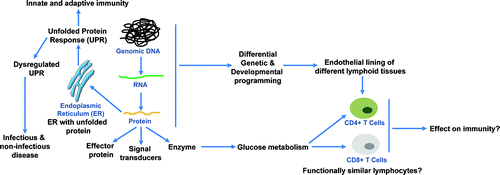The quality and magnitude of host immune responses do not rely on the genetic background alone, but also depend on several cis- and trans-regulatory factors, epigenetic modifications of genomic DNA and histones influencing transcription and translation. The expressed proteins, initially synthesized as a polymer of amino acids, undergo several biochemical modifications know as post-translational modifications (PTM), and finally, fold into appropriate functional three-dimensional conformations for the various cellular process such as cellular metabolism, cell division and responses to different stimuli. This issue of the International Reviews of Immunology focuses on the impact of biochemical processes such protein structure, immune cell metabolism and genetic factors in autoimmune disorders, metabolic syndrome, and various diseases.
In the first review by Martins et. al., the authors describe the importance of unfolded protein response (UPR) in immunity and immune homeostasis. The review discusses the capability of the UPR to activate both innate and adaptive immunity. The UPR modulate innate immunity via production of various cytokines, promoting dendritic cell maturation linked to antigen presentation capabilities. On the other hand, UPR is also involved in adaptive immunity by modulating cell survival and antibody production. The authors highlighted the role of dysregulated UPR in infectious and non-infectious diseases ().
FIGURE 1. Role of protein structure, UPR, immune cell metabolism and genetic and developmental programming in innate and adaptive immunity.

In the second review by Palmer et al., the authors discuss the metabolic activity of the proliferating CD4+ and CD8+ T cell and also compared that with the metabolism of dividing cancer cells in terms of glucose utilization. The authors describe the effect of glucose metabolism on various immune signaling pathways and suggest new approaches for therapeutic intervention in inflammatory diseases ().
Finally, in the last review of this issue by Kellermayer et al., the authors elegantly present hallmarks of genetic and development programming, and describe the molecular diversity during ontogeny of different lymphoid organs. They discuss the differential expression of various adhesion molecules, secretion of chemokines, and expression of chemokine receptors on the endothelial lining of these organ. The authors depicted these phenomena by focusing on spleen and intestinal lymphoid tissues ().
Next year's issues of the journal will focus on diverse areas of immunobiology, both basic and translational, in an attempt to bridge this gap leading to more optimal management of complex diseases.
REFERENCES
- Martins AS, Alves I, Helguero L, Domingues MR, Neves BM. The unfolded protein response in homeostasis and modulation of mammalian immune cells. International Reviews of Immunology. 2016;35(6):457–477.
- Palmer CS, Hussain T, Duette G, Weller TJ, Ostrowski M, Sada-Ovalle I, Crowe SM. Regulators of glucosemetabolism in CD4+ and CD8+ T cells. International Reviews of Immunology. 2016;35(6):478–489.
- Kellermayer Z, Hayasaka H, Kajtár B, Simon D, Robles EF, Martinez-Climent JA, Balogh P. Divergence of Vascular Specification in Visceral Lymphoid Organs—Genetic Determinants and Differentiation Checkpoints. International Reviews of Immunology. 2016;35(6):490–503.
